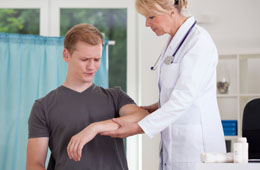Upper limb spasticity is undoubtedly an agonizing condition. Many a time, it is left undiagnosed as there isn't enough awareness about this kind of physical disability. Continue reading to know more on the causes and the treatment options for this medical condition.

Upper limb spasticity is characterized by rapid contraction or shortening of the muscles in the arm. This condition stiffens up the muscles to such an extent that it triggers abnormal muscle movements in the elbow, wrist and fingers. For this reason, these people are often found to have a tightly clenched fist or twisted wrist/elbow joint or an arm fixed in an uncomfortable position near the chest that cannot be moved. All these symptoms are extremely uncomfortable and painful. At the same time, it gravely affects the muscle coordination, which is needed for movement of the arms.
Causes
Basically, the problem of spasticity of the upper limb arises when the nervous system is damaged or injured due to some reasons. The nervous system carries out the vital function of transmission of signals between the brain and various parts of the body. The impaired nerves fail to carry the messages properly and the brain starts sending out messages randomly. This triggers rapid involuntary contraction of the muscles. It must be noted that upper limb spasticity usually does not occur as soon as you sustain a nerve damage. Rather, it develops over a period of time, which could be few weeks or months after the actual injury.
Any traumatic injury to the brain or spinal cord that destroys the nerve cells often leads to spasticity of the upper limb. In cases of spinal injury, if the location of the injury site is the cervical column, the chances of muscle spasms in the arms are high. Spasticity of the upper limb can be observed in stroke patients. This happens when stroke causes damage to that part of the brain, which controls movements of the arm muscles.
Those who are suffering from multiple sclerosis may develop this problem. This is an autoimmune disorder, which causes damage to the protective myelin sheath around the nerve cells. It has an adverse effect on transmission of the signals by the nerves. Upper limb spasticity may occur in people with cerebral palsy. It is a kind of neurological disability that damages cerebral cortex, which is actually responsible for controlling and coordinating the muscle movements in various parts of the body including the arms.
Treatment
As far as the treatment is concerned, you have to work out a plan under the guidance of a team of health care professionals who will help you out in managing this harrowing medical condition. Physical therapy is an integral part of this treatment where the physical therapist suggests some exercises involving the affected arm. Such exercises add strength to the muscles and improve mobility of the arms. They may recommend use of braces or splints to minimize muscle contraction. Then there is occupational therapy to bring about improvement in the functionality of the arms and hands. In this therapy, the therapist will modify your activities and train you to carry out daily tasks without taking help from others.
There are some medicines that are used to reduce the pain and stiffness of the muscles. Oral antispastic medicines help in relaxing the muscles, which in turn brings down the spasms. Botox injection has an amazing effect on upper limb spasticity. Botulinum toxin is a neurotoxin that blocks transmission of the signals that trigger overactivity of the muscles in the arms and hands. Thus, it lowers the stiffness of the muscles. This injection has to be administered repeatedly in order to reap its benefits. Intrathecal medicines are often used for controlling unbearable pain caused by spasticity of the upper limb. These medicines are administered directly into the spinal canal by means of a pump and plastic tube inserted into the body. In some severe cases, which were left untreated for a long time, surgery is required. During the procedure, doctors release the muscle contracture and reduce the stiffness and increase the range of motion of the arms.
Before I conclude, let me tell you that do not expect any miraculous improvement in the condition in a short span of time. I am saying this because many people feel disappointed when they cannot see results after months of rehabilitation program because of which they quit it in the middle. Set some small goals for yourself, stick to them and wait patiently for some progressive improvement. Have a strong support group of friends and family members around you, who will encourage you to fight this agonizing medical condition.


 Upper limb spasticity is characterized by rapid contraction or shortening of the muscles in the arm. This condition stiffens up the muscles to such an extent that it triggers abnormal muscle movements in the elbow, wrist and fingers. For this reason, these people are often found to have a tightly clenched fist or twisted wrist/elbow joint or an arm fixed in an uncomfortable position near the chest that cannot be moved. All these symptoms are extremely uncomfortable and painful. At the same time, it gravely affects the muscle coordination, which is needed for movement of the arms.
Upper limb spasticity is characterized by rapid contraction or shortening of the muscles in the arm. This condition stiffens up the muscles to such an extent that it triggers abnormal muscle movements in the elbow, wrist and fingers. For this reason, these people are often found to have a tightly clenched fist or twisted wrist/elbow joint or an arm fixed in an uncomfortable position near the chest that cannot be moved. All these symptoms are extremely uncomfortable and painful. At the same time, it gravely affects the muscle coordination, which is needed for movement of the arms.